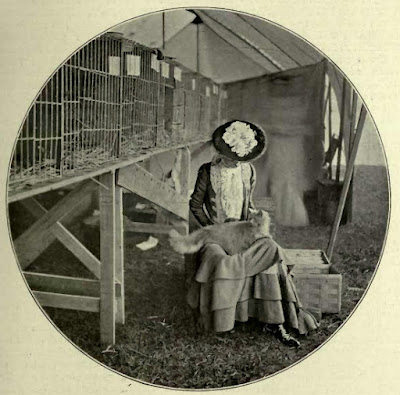On the theme of pet-keeping
in Victorian times, let’s take a look at the pets of the poor. Whilst the
middle classes and better off people treated pets as creatures in need of a
civilizing influence, the poor valued them as they were as companions.
 |
| A beloved cat such as this, was liable to be turned out onto the streets when the family went on holiday. No so the dog. |
An example of this is the
middle classes who went on holiday and put their house cat out onto the street
to fend for herself. The early animal welfare lobby objected to turning
domesticated creatures with few hunting skills onto the street where they starved.
However, the reason for this
was not what you might suspect. Their objection was the loss of a the
owner’s influence forced the animal to act in a more bestial – and therefore
less civilized- manner. It had little to do with the cruelty of
withdrawing food and shelter from a dependent animal, and much to do with the
cat’s poor morality living on the street reflecting badly on the owner.
This is contrasted with an
ex-sailor living in Houndsditch. He scandalized his neighbours by refusing to
go to church on Sundays. The reason for his absence was he refused to leave his
pet squirrel alone. As Jack explained:
“How is he to know I be
comin’ back? He give’ himself to my care, and I must be true to my charge.”
Indeed the sailors was right
to be hesitant. He allowed himself to be persuaded to go to church, but
disaster! On returning he found the squirrel had escaped. Four hours later he
found his pet…and never went back to church.
Another story of utter
devotion to a pet was that of a pet fox called Benny, and his owner living in
slums. Benny had been caught in a trap but nursed back to health by his now
owner, John. When John moved to London Benny came with him, and lived in a
cage. This was doubly necessary because the fox didn’t like children and would
have attacked John’s new born baby.
However, sometime later when
Benny fell mortally ill, despite the freezing weather John banished his
children outdoors because the sound of them playing disturbed the ailing fox.
Indeed, such was John’s devotion that Benny had first priority for food, even
if that meant his children going to bed hungry. A step too far perhaps.
And finally, one man’s
devotion to his pet, in this case an owl, saved his life. A rat-catcher had a
pet owl called Jim, which sat on his shoulder much like a parrot. The pair were
reportedly devoted to each other. Then one night Jim saved his master’s life
when burglars burst into the house and the owl woke his master to warn him, by
flapping his wings in his face.
The story goes that the
rat-catcher was no stranger to crime, and was himself arrested by the police.
Faced with a long sentence he wrote a letter of farewell to his wife saying:
“Come to the court to say
good-bye with the baby and Jim. If you cannot carry both, bring the bird.”



















































